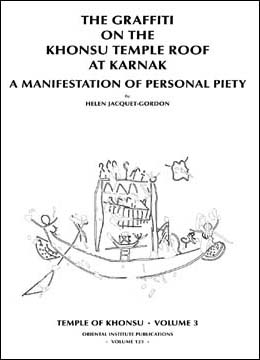OIP 123. Temple of Khonsu, Volume 3. The Graffiti on the Khonsu Temple Roof at Karnak: A Manifestation of Personal Piety. Helen Jacquet-Gordon

Purchase Download Terms of Use
Graffiti incised on the roof blocks of the temple of Khonsu at Karnak, written in the hieroglyphic, hieratic, and Demotic scripts and accompanied by the outlines of pairs of feet, caught the eye of Champollion and other early voyagers who succeeded in clambering up onto that part of the roof still remaining over the colonnade of the first court. Such graffiti have usually been interpreted as mementos left by ancient visitors passing through Thebes. A complete survey of all the graffiti on the roof and a detailed study of the inscriptions, carried out over a considerable period of time, has revealed the unexpected fact that far from being casual tourists, it was mostly the priestly personnel of the temple itself whose graffiti have been preserved there. The inscriptions record the name and titles of the person whose footprints are depicted, as well as the name of his father and sometimes that of his grandfather, but only in three cases does the name of his mother appear. Prayers addressed mainly to Khonsu himself demonstrate the firm belief of these priestly servitors in the lasting protection afforded them by the god in whose sacred precinct their graffiti have been carved.
One of the most original groups of graffiti is that connected with the family of one Djedioh, whose inscriptions dating to the time of the Twenty-second Dynasty reveal the existence of a hitherto unknown king of that era named Iny. Other objects depicted among the graffiti are "portrait" heads, sacred barks, animals, birds, and architectural elements, almost all having some connection with the temple itself or with the cult of the god Khonsu. Several small crosses give witness to the reuse of the temple in Christian times as a church.
The 334 graffiti recorded in the volume are richly illustrated by photographs and facsimile drawings. Transliterations, translations, line notes, and commentaries are provided. The text concludes with general, name, epithet, and title indices.
- Oriental Institute Publications 123
- Chicago: The Oriental Institute, 2003
- ISBN 1-885923-26-0
- Pp. xxiv + 120; 5 figures, 126 plates
- Casebound 12 x 16 in / 30.5 x 40.6 cm
- $180.00

